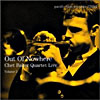
This Week: Soulive's genre-bending jazz, good reissues of Monk and another questionable one of Chet
Soulive
Doin' Something (Blue Note)

The Hammond B-3 organ, guitar, drums trio is not the classic jazz grouping that the piano, bass, drums trio is. And for some, the Hammond B-3, especially in full tremolo, is merely a reminder of baseball park schtick and church music. Soulive tables these associations, bundling them with dated Jimmy Smith and less dated Medeski, Martin, & Wood jam band notions. No, this is not your Daddy's B-3 organ trio.
Doin' Something, Soulive's first major label release, is firstly about funkiness and a dance groove not typically associated with CDs in the jazz trough, organ trio or no. Making this album particularly pleasurable is the addition of Fred Wesley's (of James Brown fame) trombone and horn arrangements to Neal Evans' B-3, Eric Krasno's guitar, and Alan Evans' drums.
The biggest challenge of this album is keeping your feet still while listening. It absolutely begs bodily motion. While the liner notes recommend that Doin' Something be "bumped in your jeep," caveat emptor. The in-the-pocket pulse and soulful horn arrangements are not conducive to concentrating on I-40 traffic.
While the CD opens with a catchy enough vibe on "Hurry Up...And Wait," the real danger area is on the second tune, the title track. On this one, Wesley's trombone and horn arrangement contribution is most manifest, laying on the accents and adding considerable soul to the cut.
Doin' Something is one genre-bending and upbeat major label debut, with potential to appeal to a broad audience, its only danger being its difficult categorization in these market-segmented and narrowcasting times. There's a crease where jazz, funk, hip hop, and soul meet: Soulive lives and grooves there.
—Jonathan B. Frey
Thelonious Monk
Monk in Tokyo; At the Jazz Workshop (Columbia)

Monk's response to snowballing public acclaim in the early '60s was to restate, on record and in person, the repertoire he'd forged in the early years before; these valuable reissues document that consolidation period in the pianist's career. The material is familiar, but the spirited performances bar any question of diminishing returns. Blowing tenor on both albums is Charlie Rouse, whose pithy style throws Monk's singular keyboard geometry into sharp relief.
From a watertight "Straight No Chaser" onward, the Tokyo concert hall date from May 1963 illuminates 11 classics with authority, humor, and an inimitable sense of space (something Monk's music demands but doesn't always receive). Rouse is more venturesome than usual, darting through "Hackensack" and teasing the crowd in "Epistrophy," while the rhythm section bristles throughout. Monk is in top form; he injects his chordal labyrinths with trademark whole-tone runs, pungent clusters, and jagged blues lines, simultaneously fulfilling the tags of high priest and jester. A very cohesive quartet and gig.
In contrast, the Jazz Workshop proceedings from the following year are much looser and at times fall into disarray—"Thelonious" is a shambles, "Misterioso" works uphill after an opening theme miscue, and Rouse doesn't sound comfortable with the up tempo "Round Midnight." But these are minor blips in some 2-1/2 hours worth of otherwise orderly work. The perennial "Well You Needn't" and a bouncing "Bright Mississippi" stand out. Not essential...but with the volume up and a cocktail in hand, worthwhile.
—Chris Mitchell
Chet Baker
Out of Nowhere (Pacific Jazz)

"Trombo Doro" (golden trumpet). "High class hobo." Both have been used to describe Chet Baker, another in the jazz pantheon whose dissipated life has been elevated to the mythical: inchoate fame, lifelong heroin addiction, decline into obscurity after a tooth-removing bar brawl, re-emergence, and mysterious death tumble from an Amsterdam hotel window.
An autodidact who arrived with the essentials of his style fully formed, Baker was a trumpeter noted for his yielding tone, softness of attack, and inventive improvisation.
Baker was a prolific artist, with 200-plus recordings during his lifetime; unfortunately for the jazz enthusiast, many are of marginal quality, with the marginal being oddly the more often reissued. Out of Nowhere is not exactly in the latter category, although having been recorded in 1954, it lacks the mature power of Baker's clean and sober 1960s sides.
Nowhere opens particularly poorly, with Russ Freeman on piano sounding more surprised to be playing at all then stating the head. This fumble-fingered offering is followed by an equally surprised sounding Baker, who proceeds to fluff nearly an entire line of the theme. Perhaps to make up for such a dismal start, the tune extends for an uncharacteristically long 10-plus minutes, during which Baker masters his embouchure and Freeman his fingers, only apparently to lose the tune's form five minutes later.
There are more auspicious moments on the recording, most particularly on "Stella by Starlight" and on "Carson City Stage," where there is actually some astonishing displays of technique, especially given the tentativeness exhibited elsewhere. Otherwise, this CD deserves the same uncertain applause that the audience provided the live performance.
—Jonathan B. Frey

August 30, 2001 * Vol. 11, No. 35
© 2001 Metro Pulse
|